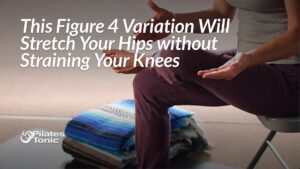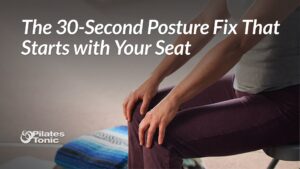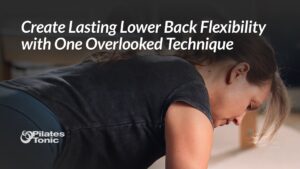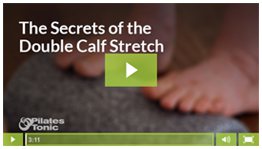I just returned from a workshop with Marie José Blom in California. I can't think of a better experience to set the stage for the following 3 exercises.
Previously, we discussed softening the knees, awareness of where the weight is distributed through the feet and how to bookmark these feelings in the body. (Keep an eye out for further info on the ankles, feet and knees—I learned so much more from the workshop I just attended and can’t wait to share it with you! 🙂 )
Now we’ll move upwards from the foundation to the midsection of the body for these next three foundational exercises.
4. The Diaphragm is a Core Muscle Too
I've always known that learning to breathe correctly was important, but I never realized the impact breathing has on posture and the many important roles the diaphragm plays in maintaining structural body health.
The diaphragm is your breathing muscle. It's a dome shaped muscle (similar to a jellyfish in shape) that forms the floor of your thorax. It has deep muscle fibers that reach out and insert into the tips of the 11th and 12th ribs and has tendon-like extensions into the vertebral bodies. It also has visceral relationships with the lungs, heart, pulmonary system, lymphatic system, iliopsoas, sacrum and spine. Because of these relationships, the diaphragm acts as a massage therapist to the internal organs and a chiropractor for your sacrum and spine. That's a lot of responsibility for one muscle!
Good posture and a healthy, functioning body structure are the result of breathing properly and understanding how best to activate and monitor your diaphragm.
When we get stressed out, or develop a habit of breathing shallowly, or only into the chest, it has strong, negative impact throughout the entire body.
The exercise below is a great way to help you discover how efficiently you’re breathing. If you’re breathing inefficiently, this will help you fix it.
The Seated Breathing Wave
(Try this exercise seated, lying on your stomach and lying on your back.)
- Place the back of your hands on your low back.
- Take a breath in and feel your low back filling out into your hands.
- Exhale and feel the lower back move away from your hands.
- After taking a couple breaths in this manner, notice whether or not your breath has slowed down.
- Empty your lungs out on the next exhale, seeing if you can exhale a little past the point where you feel you've blown all the air out. This will give you room for more air on your next inhale.
- See of you can inhale to the count of 4, filling your lungs and letting the belly and low-back expand.
- Exhale slowly to at least the count of 4. Notice how the abdominal muscles will naturally draw back toward your spine without any effort.
 5. Multifidus, The “Conductor” of the Core
5. Multifidus, The “Conductor” of the Core
The multifidi are the deepest muscles on the spine and when they engage, other core muscles (the transverse abdominals and pelvic floor) are also engaged automatically. Because of this co-contraction that happens when the multifidi engage, they act as a conductor for the other core musculature of the body. Stay with me, this is a big deal and really cool (and not just for anatomy geeks). 🙂
The feeling of the multifidus in the body can be such a subtle feeling at first that it may be difficult to sense at all. Using mental imagery and your breath are the best way to access this muscle group.
Although we use many different images to find the multifidus, I'd like to share one that tends to work well for a lot of folks.
- Start by sitting tall with the bottom bones evenly grounded on the floor. Then rock forward a tiny bit to the front side of your bottom bones.
- Imagine you are wearing a pair of sweat pants, but backwards with the drawstring in the back, right at the top your sacrum.
- Take a breath in and as you exhale, imagine gathering the drawstring to the center of your sacrum and then dragging it up one vertebra.
- You should get feeling of lift in your spine—try to maintain that feeling and begin to work your way up your spine. Inhale and as you exhale gather and lift the drawstring up another vertebra higher.
- Check to make sure that your glutes, thighs, hip crease, shoulders and neck stay relaxed. These are all bigger muscles that love to help out and steal the show. Don't let them.
You may find that in certain areas of your back you can feel the sensation of the multifidus and in other areas you can't. This is normal. As you practice this exercise, you will find the sensation of the multifidus gets stronger and easier to find.
6. Smile Across Your Hip Bones
While you were gathering and lifting the drawstring on your spine, did you feel anything going on in the front of the body, most importantly, deep in the low abdominals? The deepest abdominal muscle (the transverse abdominal) turns on when the multifidus is engaged in this manner.
The transverse abdominal (TA) is the deepest layer of the abdominal muscles. It is the body’s inner corset. It actually attaches to the fascia that attaches to your lumbar spine. When the TA engages, it flattens across the front of the body and creates a pull on the lumbar fascia which contributes to the stability of the lumbar spine.
The TA is responsible for creating the look of flat abdominals, as well as the hour glass shape so many of us like and are working to create. 🙂
The TA can also be a subtle muscle to find at first and the other abdominal muscles will try and disguise themselves as the TA. Here's an exercise to locate and begin to strengthen the TA. You can do this lying on your back, sitting or standing; whichever is most comfortable for you.
- Find the front of your hip bones and slip the pads of your fingers right on the inside of each hip bone. Then slide your fingers about an inch towards the center.
- Now smile across your face and notice how the corners of your mouth draw up.
- Bring your awareness back down to your fingers on the inside of each hip bone. Locate your pubic bone and imagine a smile just beginning to form above that area.
- Take a breath in and as you exhale imagine the corners of the smile forming above your hip bones beginning to widen. Draw the corners of the smile up towards the fingers on the inside of each hip bone.
- The feeling you are looking for is one of widening, or spreading and drawing up. If you feel a bulge into your fingertips, that is your internal obliques and not the feeling you are looking for.
On a scale of 1-10, you want to engage the TA at about level 5. Once you've found your smile, see if you can maintain it. Take another breath in and as you exhale, feel the smile widen and draw in and up further. See how many breath cycles you can keep the smile going without feeling the internal obliques bulge into your fingertips.
The above exercises are vital to improving body function and gaining an important understanding of your body’s foundational mechanics. Having conscious control over these fundamental systems will open up a whole new world of improved physical health.
Connecting your conscious awareness with these core muscle systems will help you make huge positive advancements in everything you do, whether it's taking a Pilates class, gardening, playing a sport, sitting at a desk, or cooking in the kitchen. These core muscles are the source of much of your basic stability; if muscles were runners, these would be your marathon runners.
If the body has gotten out of sync with these core muscle connections it will remember quickly. It just needs a gentle reminder. 🙂
Stay tuned for the 3rd article in this series when we continue to move on up the body to the head, neck and shoulders.
Yours in creating a new normal!
Sydney




